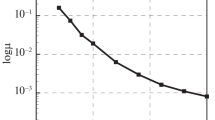Abstract
The paper presents key results on a large-scale entrainment of thermoviscous liquid layers with different temperatures and their further mixing observed in the plane-parallel flow with an inflectional velocity profile. We show that the instability development in the channel is more intensive at the inflection point vicinity and is not related directly to vorticity generation in the near-wall region. The considered flow being unstable relative to the finite-amplitude harmonic disturbances possesses several resonant frequencies initiating the most intense entrainment. Temperature fields are analyzed based on the time-averaged entrainment layer thickness and temperature isoline displacement. We discuss the spectral properties of flow enstrophy, vorticity, and kinetic energy in terms of asymptotics of cascades observed and coherent structures. Okubo-Weiss criterion is used for mapping of four flow zones wherein an active filamentation of the turbulent veil or long-term existence of vortex structures is possible.
Similar content being viewed by others
References
C.—S. Yih, Instability due to viscosity stratification, J. Fluid Mech., 1967,Vol. 27, No. 2, P. 337–352.
M.C. Potter and E.J. Graber, Stability of plane Poiseuille flow with heat transfer, NASA TN D-6027. 1970.
S.F. Urmancheev, Flow in thermoviscous media, in: Proc. Nizhegorodksii University named after Lobachevsky, 2011, Vol. 3, No. 4, P. 1197–1199.
P.G. Drazin and W.H. Reid, Hydrodynamic Stability. 2nd ed., Cambridge University Press, 2004.
A.S. Monin, On the nature of turbulence, Soviet Physics — Uspekhi, 1978, Vol. 21, No. 5, P. 429–442.
Y.M. Kulikov and E.E. Son, Fluid flow with abrupt viscosity-temperature dependence, High Temperature, 2014, Vol. 52, No. 5, P. 723–729.
Y.M. Kulikov and E.E. Son, Stability of thermoviscous fluid flow under high temperature gradients, High Temperature, 2017, Vol. 55, No. 5, P. 131–138.
V.M. Goloviznin and A.A. Samarskiy, About properties of “Cabaret” difference scheme, Matematicheskoe Modelirovanie, 1998, T. 10, No. 1, P. 101–166.
V.M. Goloviznin, M.A. Zaitsev, S.A. Karabasov, and I.N. Korotkin, New Algorithms for Computational Fluid Flow Adapted for Multi-processor Computer Complexes, Moscow Univ. Publishing, 2013.
Y.M. Kulikov and E.E. Son, The CABARET method for a weakly compressible fluid flows in one- and two-dimensional implementations, J. Physics: Conference Series, 2016, Vol. 774, No. 1, P 012094–1–012094–16.
G.G. Chernyi, Gas Dynamics: Textbook for Universities, Nauka, (Glavn. Redak. Fiz.-mat. Liter.), Moscow, 1988.
V.Yu. Glotov, A mathematical model of free turbulence based on maximum principle: PhD. Thesis: 05.13.18. Moscow, 2014.
A.K.M.F. Hussain, Coherent structures — reality and myth, Phys. Fluids, 1983, Vol. 26, No. 10, P. 2816–2850.
L.G. Loitsyanskii, Mechanics of Liquids and Gases, Pergamon Press, 2014.
P.E. Dimotakis, The mixing transition in turbulent flows, J. Fluid Mech., 2000, Vol. 409, P. 69–98.
P. Huerre and P.A. Monkewitz, Absolute and convective instabilities in free shear layers, J. Fluid Mech., 1985, Vol. 159, P. 151–168.
K. Ohkitani, Wave number space dynamics of enstrophy cascade in a forced two-dimensional turbulence, Phys. Fluids A, 1991, Vol. 3, Iss. 6, P. 1598–1611.
G.K. Batchelor, Computation of the energy spectrum in homogeneous two-dimensional turbulence, Phys. Fluids, 1969, Vol. 12, No. 12, P. II–233–II–239.
R.H. Kraichnan, Inertial ranges in two-dimensional turbulence, Phys. Fluids, 1967, Vol. 10, No. 7, P. 1417–1423.
P.A. Davidson, Turbulence: An Introduction for Scientists and Engineers, Oxford, N.Y., 2004.
C. Basdevant and T. Philipovitch, On the validity of the “Weiss criterion” in two-dimensional turbulence, Phys. D, 1994, Vol. 73, Nos. 1–2, P. 17–30.
Author information
Authors and Affiliations
Corresponding author
Additional information
Research was financially supported by the Russian Foundation for Basic Research (Project No. 15-08-00457).
Rights and permissions
About this article
Cite this article
Kulikov, Y.M., Son, E.E. On stability of channel flow of thermoviscous fluid. Thermophys. Aeromech. 24, 883–900 (2017). https://doi.org/10.1134/S0869864317060075
Received:
Revised:
Published:
Issue Date:
DOI: https://doi.org/10.1134/S0869864317060075



